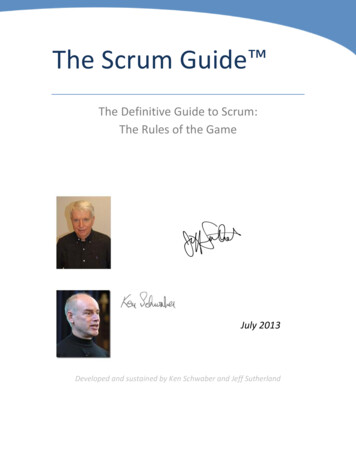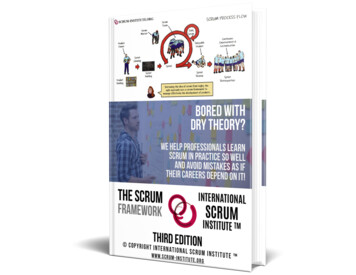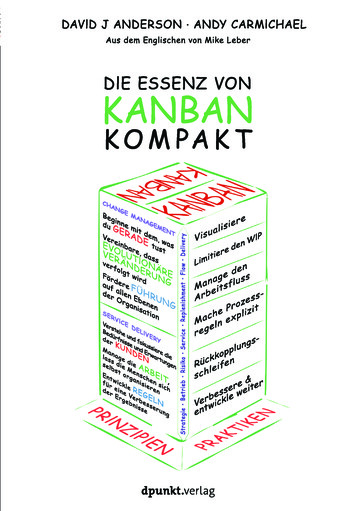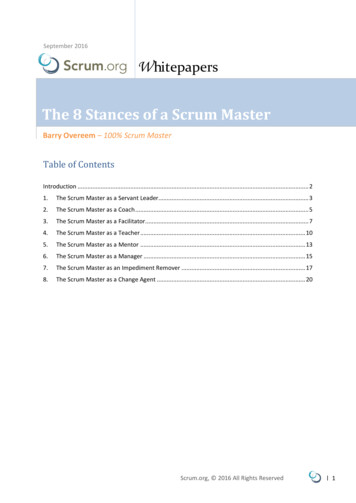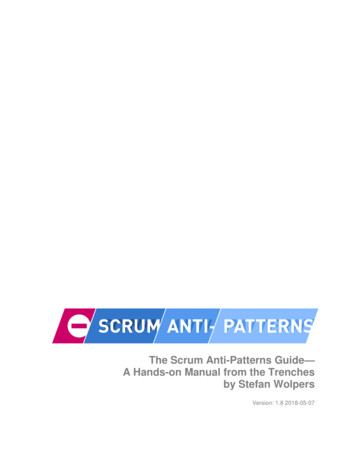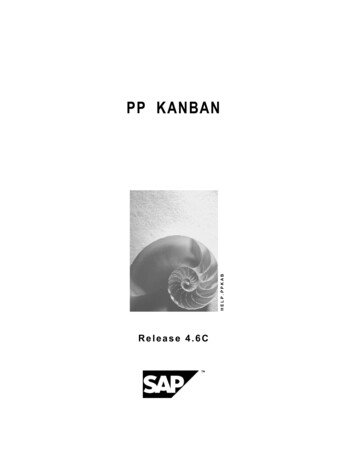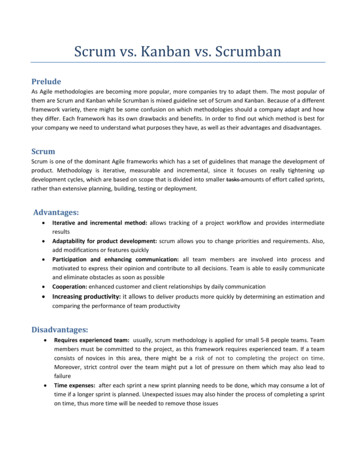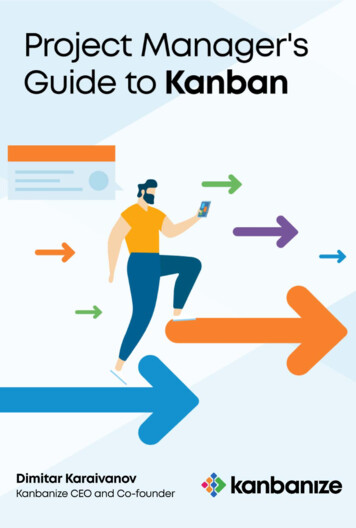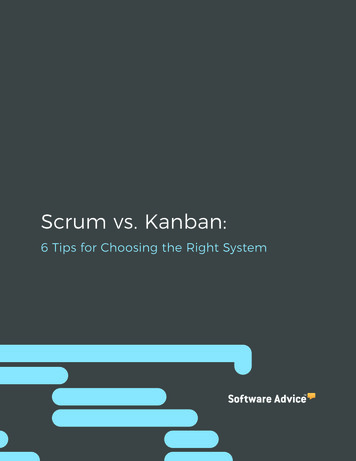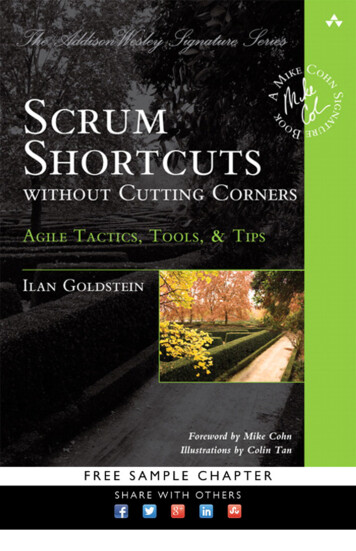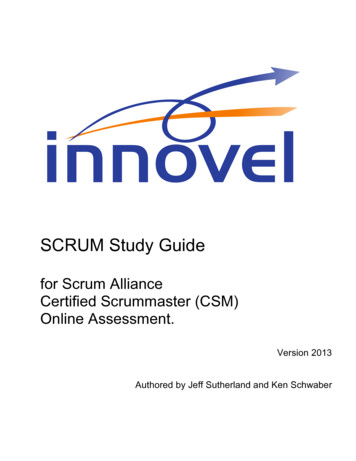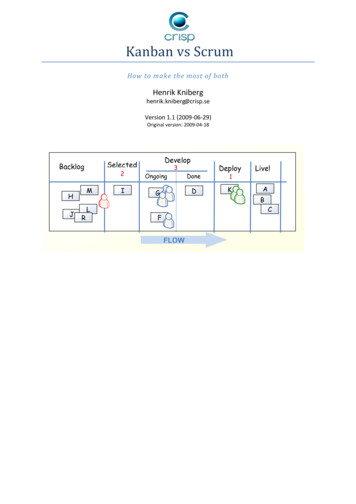
Transcription
Kanban vs ScrumHow to make the most of bothHenrik Kniberghenrik.kniberg crisp.seVersion 1.1 (2009-06-29)Original version: IGDDeploy1KLive!ABCFFLOW
Kanban vs Scrum – howow to make the best of bothHenrik Kniberg1.Introduction . 32.So what is Scrum and Kanban anyway?. 43.So how do they relate to each other? . 64.Scrum prescribes roles. 105.Scrum prescribes timeboxed iterations . 116.Kanban limits WIP per workflow state, Scrum limits WIP per iteration . 137.Both are empirical . 158.Scrum resists change within an iteration . 209.Scrum board is reset between each iteration . 2210.Scrum prescribes cross-functionalfunctional teams . 2311.Scrum backlog items must fit in a sprint . 2412.Scrum prescribes estimation and velocity . 2513.Both allow working on multiple products simultaneously . 2614.Both are Lean and Agile . 2815.Minor differences . 2916.Scrum board vs Kanban board – a less trivial example . 3117.Summary of Scrum vs Kanban . 3918.Take-away points . 40page 2 / 40
Kanban vs Scrum – howow to make the best of bothHenrik Kniberg1. IntroductionThere’s a lot of buzz on Kanban right now in the agile software development community. Since Scrumhas become quite mainstream now, a common question is “so what is Kanban, and how does itcompare to Scrum?” Where do they complement each other? Are there any potential conflicts?Here’s an attempt to clear up some of the ···Jim: “Now we’ve finally gone all-outallScrum!”Fred: “ So how’s it going?”w had before.”Jim: “Well, it’s a lot better than what weFred: “.but?”Jim: “. but you see we are a support & maintainance team.”Fred: “yes, and?”selfJim: “Well, we love the whole thing about sorting priorities in a product backlog, selforganizing teams, daily scrums, retrospectives, etc.”Fred: “So what’s the problem?”Jim: “We keep failing our sprints”Fred: “Why?”Jim: “Because we find it hard to commit to a 2 week plan. Iterations don’t make to muchsense to us, we just work on whatever is most urgent for today. Should we do 1 weekiterations perhaps?”Fred: “Could you commit to 1 week of work? Will you be allowed to focus and work in peacefor 1 week?”Jim: “Not really, we get issues popping up on a daily basis. Maybe if we did 1 day sprints.”Fred: “Do your issues take less than a dayda to fix?”Jim: “No, they sometimes take several days”Fred: “So 1-dayday sprints wouldn’t work either. Have you considered ditching sprints entirely?”Jim: “Well, frankly, we would like that. But isn’t that against Scrum?”Fred: “Scrum is just a tool. You choosechoose when and how to use it. Don’t be a slave to it!”Jim: “So what should we do then?”Fred: “Have you heard of Kanban?”Jim: “What’s that? What’s the difference between that and Scrum?”Fred: “Here, read this article!”articleJim: “But I really like the rest of Scrum though, do I have to switch now?”Fred: “No, youou can combine the techniques!”Jim: “What? How?”Fred: “Just read on.”Purpose of this articleIf you’re interested in agile software development you’ve probably heard about Scrum, and you mayalso haveve heard about Kanban. I hope this article will clarify both tools by comparing them to eachother, so you can figure out how these might come to use in your environment.page 3 / 40
Kanban vs Scrum – howow to make the best of bothHenrik Kniberg2. So what is Scrum and Kanban anyway?OK let’s try to summarize Scrum and Kanban in lessles than 100 words each.Scrum in a nutshell·Split your organization into small, cross-functional,crossself-organizing teams.·Split your work into a list of small, concrete deliverables. Sort the list by priority andestimate the relative effort of each item.·Split time into short fixed-lengthlength iterations (usually 1 – 4 weeks), with potentially shippablecode demonstrated after each iteration.·Optimize the release plan and update priorities in collaboration with the customer, based oninsights gained by inspectingecting the release after each iteration.Optimize the process by having a retrospective after each iteration.·So instead of a large group spending a long time building a big thing,we have a small team spending a short time building a small thing.But integrating regularly to see the whole.121 words. close enough.page 4 / 40
Kanban vs Scrum – howow to make the best of bothHenrik KnibergFor more details check out “Scrum and XP from the Trenches”. The book is a free read online. I knowthe author, he’s a nice guy tmlFor more Scrum links check out http://www.crisp.se/scrumKanban in a nutshell···Visualize the workflowo Split the work into pieces, write each item on a card and put on the wallo Use named columns to illustrate where each item is in the workflow.Limit WIP (work in progress)gress) – assign explicit limits to how many items may be in progress ateach workflow state.Measure the lead time (average time to complete one item,, sometimes called “cycle time”)time”),optimize thehe process to make lead time as small and predictable as possible.possibWe collect useful Kanban links at: http://www.crisp.se/kanbanpage 5 / 40
Kanban vs Scrum – howow to make the best of bothHenrik Kniberg3. So how do they relate to each other?Scrum and Kanban are both process toolsTool anything used as a means of accomplishing a task or purpose.purpose Process how you work.Scrum and Kanban are process tools in that they help you work more effectively by,, to a certainextent, telling you what to do. Java is alsoa a tool, it gives you a simpler way to programming acomputer. A toothbrush is a also a tool, it helps you reach your teeth so youyou could clean them.Compare tools for understanding, not judgementKnife or fork – which tool is better?Pretty meaningless question right? Because the answer depends on your context. For eatingmeatballs the fork is probably best. For chopping mushroomsmushrooms the knife is probably best. Fordrumming on the table either will do fine. For eating a steak you probably want to use both toolstogether. For eating rice. well. some prefer fork while others prefer chopsticks.So when we compare tools we should bebe careful. Compare for understanding, not for judgement.No tool is complete, no tool is perfectLike any tools, Scrum and Kanban are neither perfect nor complete. They don’t tell you everythingthat you need to do, they just provide certain constraints & guidelines. For example, Scrumconstrains you to have timeboxed iterations and cross-functionalcrossteams, and Kanban constrains youto use visible boards and limit the size of your queues.Interestingly enough, the value of a tool is that it limits your options. A process tool that lets you doanything is not very useful. We might call that process “Do Whatever” or how about “Do The RightThing”. The “Do The Right Thing” process is guaranteed to work, it’s a silver bullet! Because if itdoesn’t work, you obviouslyiously weren’t following the process :o)page 6 / 40
Kanban vs Scrum – howow to make the best of bothHenrik KnibergUsing the right tools will help you succeed, but will not guarantee success. It's easy to confuse projectsuccess/failure with tool success/failure.····A project may succeed because of a great toolA project may succeedeed despite a lousy toolA project may fail because of a lousy toolA project may fail despite a great toolScrum is more prescriptive than KanbanWe can compare tools by looking at how many rules they provide. Prescriptive means “more rules tofollow” and adaptive means “fewer rules to follow”. 100% prescriptive means you don’t get to useyour brain, there is a rule for everything. 100% adaptive means Do Whatever,hatever, there are no rules orconstraints at all. As you can see, both extremes of the scale are kindkin of ridiculous.Agile methods are sometimes called lightweight methods, specifically because they are lessprescriptive than traditional methods. In fact, the first tenet of the Agile Manifesto is “Individuals andInteractions over Processes and Tools”.Scrum and Kanban are both highly adaptive, but relatively speaking Scrum is more prescriptive thanKanban. Scrum gives you more constraints, and thereby leaves less options are open. For exampleScrum prescribes the use of timeboxed iterations, Kanban doesn’t.page 7 / 40
Kanban vs Scrum – howow to make the best of bothHenrik KnibergLet’s compare some more process tools on the prescriptive vs adaptive scale:RUP is pretty prescriptive – it has over 30 roles, over 20 activities, and over 70 artifacts. Anoverwhelming amount of stuff to learn. You aren’t really supposed to use all of that though, you aresupposed to select a suitable subset for your project. Unfortunately thishis seems to be hard in practice.“Hmmmm. will we need Configuration audit findings artifacts? Will we need a Change controlmanager role? Not sure, so we betteretter keepkee them just for in case.” This may be one of the reasonswhy RUP implementations often end up quite heavy-weightheavycompared to Agile methods such asScrum and XP.XP (eXtreme programming) is pretty prescriptive compared to Scrum. It includes most of Scrum abunch of fairly specific engineering practices such as test-driventest driven development and pair programming.Scrum is less prescriptive than XP, since it doesn’t prescribe any specific engineering practices. Scrumis more prescriptive than Kanban though,thou , since it prescribes things such as iterations and crosscrossfunctional teams.One of the main differences between Scrum and RUP is that in RUP you get too much, and you aresupposed to remove the stuff you don’t need. In Scrum you get too little, and you are supposed toadd the stuff that is missing.Kanban leaves almost everything open. The only contraints are VisualizeVisual Your Workflow and LimitYour WIP. Just inches from Do Whatever, but still surprisingly powerful.page 8 / 40
Kanban vs Scrum – howow to make the best of bothHenrik KnibergDon’t limit yourself to one tool!Mix and match the tools as you need!need! I can hardly imagine a successful Scrum team that doesn’tinclude most elements of XP for example. Many Kanban teams use daily standup meetings ((a Scrumpractice). Some Scrum teams write some of their backlog items as Use Cases (a RUP practicepractice) or limittheir queue sizes (a Kanban practice). Whatever works for you.Musashi said it nicely (famous 17th century Samurai, famous for his twin-swordtwin sword fighting technique)Do not develop an attachement to anyone weapon or any one school of fighting- Miyamoto MusashiPay attention to the constraints of each tool though.though For example if you use Scrum and decide tostop using timeboxed iterations (or any other core aspect of Scrum), then don’t say you’re usingScrum. Scrum is minimalistic enough as it is,is if you remove stuff andnd still call it Scrum then the wordwill become meaningless and confusing.confusing Call it something like “Scrum-inspired”inspired” or “a subset ofScrum” or how about “Scrumish” :o)page 9 / 40
Kanban vs Scrum – howow to make the best of bothHenrik Kniberg4. Scrum prescribes rolesScrum prescribes 3 roles: Product Ownerwner (sets product vision & priorities), Team (implements theproduct) and Scrum Master (removesremoves impediments and provides process leadership).Kanban doesn’t prescribe any roles at all.That doesn’t mean you can’t or shouldn’t have a Product Owner role in Kanban! It just means youdon’t have to. In both Scrum and Kanban you are free to add whatever additional roles you need.Be careful when adding roles though, make sure the additional roles actually add value and don’tconflict with other elements of the process. Are you sure you need that Project Manager role? In abig project maybe that’shat’s a great idea, perhaps that’s the guy who helps multiple teams & productowners synchronize with each other. In a small project that role might be waste, or worse, might leadto suboptimization and micromanagement.The general mindset in both Scrum andand Kanban is “less is more”. So when in doubt, start with less.In the rest of the article I’m going to use the term “Product Owner” to represent whoever it is thatsets the priorities of a team, regardless of the process used.usedpage 10 / 40
Kanban vs Scrum – howow to make the best of bothHenrik Kniberg5. Scrum prescribes timeboxedtimeboxe iterationsScrum is based on timeboxed iterations.iteration . You can choose the length of the iteration, but the generalidea is to keep the same length of iteration over a period of time and thereby establish a cadence.·Beginning of iteration: An iteration plan is created, i.e. team pulls out specific number itemsfrom the product backlog, based on the product owner’sowner s priorities and how much the teamthinks they can complete in one iteration.·During iteration: Team focuses on completing the items they committed to. The scope of theiteration is fixed.·End of iteration: Team demonstrates working code to the relevant stakeholders, ideally thiscode should be potentially shippable (i.e. tested and ready to go). Then the team does aretrospective to discuss and improveimprtheir process.So a Scrum iteration is one single timeboxed cadence combining three different activities: planning,process improvement, and (ideally) release.In Kanban timeboxed iterations are not prescribed. You can choose when to do planning, proprocessimprovement, and release. You can choose to do these activities on a regular basis (“release(“release everymonday”) or on-demanddemand (“release whenever we have something useful to release”) .page 11 / 40
Kanban vs Scrum – howow to make the best of bothHenrik KnibergTeam #1 (single cadence)“We do Scrum iterations”Team #2 (three cadences)“We have three difference cadences. Every week we release whatever is ready for release. Everysecond week we have a planning meeting and update our priorities and release plans. Every fourthweek we have a retrospective meeting to tweak and improveimprour process”Team #3 (mostly event-driven)driven)“We trigger a planning meeting whenever we start running out of stuff to do. We trigger a releasewhenever there is a MMF (minimum marketable feature set) ready for release. We trigger aspontaneous quality circle whenever we bump into the same problem the second time. We also do amore in-depthdepth retrospective every fourth week.”page 12 / 40
Kanban vs Scrum – howow to make the best of bothHenrik Kniberg6. Kanban limits WIP per workflow state, Scrum limits WIPper iterationIn Scrum, the sprint backlog shows what tasks are to be executed during the current iteration ( “sprint” in Scrum-speak).speak). This is commonly represented using cards on the wall,, called a Scrum bboardor Task board.So what’s the difference between a Scrum board and a Kanban board? Let’s start with a triviallysimple project and compare the two:Scrum boardTo doKanban boardOngoing Done :o)To doOngoing Done :o)2AABBCCDDFLOWFLOWIn both cases we’re tracking a bunch of items as the progress through a workflow. We’ve selectedthree states: To Do, Ongoing, and Done. You can choose whatever statesstyou like – some teams addstates such as Integrate, Test, Release, etc. Don’t forget the less is more principle though.So what’s’s the difference between these two sample boards then? Yep - the little 2 in the middlecolumn on the kanban board. That’s all. That 2 means “there may be no more than 2 items in thiscolumn at any given moment”.In Scrum there is no rule preventing the team from putting all items into the Ongoing column at thesame time! However there is an implicit limit since the iteration itself has a fixed scope. In this casethe implicit limit per column is 4, since there are only 4 items on the whole board. So Scrum limitsWIP indirectly, while Kanban limits WIP directly.Most Scrum teams eventually learn that it is a bad idea to have tootoo many ongoing itemsitems, and evolvea culture of trying to get the current items done before starting new items. Some even decide toexplicitly limit the number of items allowed in the Ongoing column and then – tadaaa – the Scrumboard has become a Kanban board!page 13 / 40
Kanban vs Scrum – howow to make the best of bothHenrik KnibergSo both Scrum and Kanban limit WIP, but in different ways.ways. Scrum teams usually measure velocity –how many items (or corresponding units such as “story points”) get done per iteration. Once theteam knows their velocity, that becomes their WIP limitlimi (or at least a guideline). A team that has anaverage velocity of 10 will usually not pull in more than 10 items (or story points) to a sprint.So in Scrum WIP is limited per unit of time.In Kanban WIP is limited per workflow state.stateIn the above Kanban example, at most 2 items may be in the workflow state “Ongoing” at any giventime, regardless of any cadence lengths. You need to choose what limit to apply to which workflowstates, but the general idea is to limit WIP of all workflow states, starting ass early as possible andending as late as possible along the value stream. So in the example above we should consideradding a WIP limit to the “To do” state as well (or whatever you call your input queue)queue). Once we haveWIP limits in place we can start measuringsuring and predicting lead time,, i.e. the average time for an itemto moveve all the way across the board. Having predictable lead times allows us to commit to SLAs(service-level agreements)) and make realistic release plans.If the item sizes vary dramaticallylly then you might consider having WIP limits defined in terms of storypoints instead, orr whatever unit of size you use.use Some teams invest effort in breaking down ititems toroughly the same size to avoid these types of considerations and reduce time spent on estimatingthings (you might even consider estimation to be waste).waste). It’s easier to create a smoothsmooth-flowingsystem if items are roughly equal-sized.sized.page 14 / 40
Kanban vs Scrum – howow to make the best of bothHenrik Kniberg7. Both are empiricalImagine if there were knobs on these meters, and you could configure your processprby simply turningthe knobs. “I want high capacity, low lead time, high quality, and high predictability. So I’ll turn theknows to 10, 1, 10, 10 respectively.”Wouldn’t that be great? Unfortunately there are no such direct controls. Not that I know of at least.Let me know if you find any.Instead what we have is a bunch of indirect controls.Scrum and Kanban are both empirical in the sense that you are expected to experiment with theprocess and customize it to your environment. In fact, you have to experiment.xperiment. Neither Scrum norKanban provide all the answers – they just give you a basic set of constraints to drive your ownprocess improvement.·Scrum says you should have cross-functionalcrossteams. So who should be on what team? Don’tknow, experiment.·Scrum says the team chooses how much work to pull into a sprint. So how much should theypull in? Don’t know, experiment.·Kanban says you should limit WIP. So what should the limit be? Don’t know, experiment.As I mentioned earlier, Kanbannban imposes fewer constraintsconstthan Scrum. This means you get moreparameters to think about, more knobs to turn. That can be both a disadvantage or an advantagedepending on your context. When you open up the configuration dialog of a software tool, doyou prefer having 3 optionss to tweak, or 100 options to tweak? Probably somewhere in between.Depends on how much you need to tweak and how well you understand the tool.page 15 / 40
Kanban vs Scrum – howow to make the best of bothHenrik KnibergSo let’s say we reduce a WIP limit,, based on the hypothesis that this will improve our processprocess. Wethen observe how things like capacity, lead time, quality, and predictability change. We drawconclusions from the results and then change some more things, continuously improving ourprocess.Leank), Inspect & AdaptThere are many names for this. Kaizen (continuous improvement in Lean-speak),(Scrum-speak),speak), Empirical Process Control, or why not The Scientific Method.The most critical element of this is the feedback loop. Change something Find out how it went Learn from it Change something again. Generally speaking you want as short feedback loop aspossible, so you can adapt your process quickly.In Scrum, the basic feedback loop is the sprint. There are more, however, especially if you combinewith XP (eXtreme programming):When done correctly,orrectly, Scrum XP gives you a bunch of extremely valuable feedback loops.The inner feedback loop,, pair programming,programming is a feedback loop of a few seconds. Defectsefects are foundand fixed within seconds of creation ("Hey,("H isn't that variable supposed to be a 3?") . This is a "are webuildinguilding the stuff right?" feedback cycle.The outer feedback loop, the sprint,, gives a feedback cycle of a few weeks. This is a "are we buildingthe right stuff?" feedback cycle.What about Kanban then? Well, first of all you can (and probably should) put all of the abovefeedback loops into your process whether or not you use Kanban. What Kanban then gives you is afew very useful real-time metrics.··Average lead time. Updatedpdated every time an item reaches “Done” (or whatever you call yourright-most column).Bottlenecks. Typical symptom is that Column X is crammed with items while column X 1 isempy. Look for “air bubbles” on your board.page 16 / 40
Kanban vs Scrum – howow to make the best of bothHenrik KnibergThe nice thing about real-timetime metrics is that you can choose the length of your feedback looploop, basedon how often you arere willing to analyze the metrics and make changes.changes Too long feedback loopmeans your process improvement will be slow. Too short feedback loop means your process mightnot have time to stabilize between each change, which can cause thrashing.In fact, thee length of the feedback loop itself is one of the things you can experiment with. sort oflike a meta-feedback loop. OK I’ll stop now.Example: Experimenting with WIP limits in KanbanOne of the typical “tweak points” of Kanban is the WIP limit. So how do we know if we got it right?Let’st’s say we have a 4 person team, and we decide to start with a WIP limit of 1.Whenever we start working on one item, we can’t start any new item until the first item is Done. Soit will get done really quickly.Great! But then it turns out that it’s usually not feasible for all 4 people to work on the same item (inthis sample context), so we have peopleople sitting idle. If that only happens once in a while that’s noproblem, but if it happens regularly, the consequence isi that the average lead time will increase.Basically, WIP of 1 means items will get through “Ongoing” really fast once they get in, but they willbe stuck in “To Do” longer than necessary, so the total lead time across the whole workflow will beunnecessarily high.page 17 / 40
Kanban vs Scrum – howow to make the best of bothHenrik KnibergSo if WIP of 1 was too low, what about increasing it to 8?That works better for a while. We discover that, on average, working in pairs gets the work donemost quickly. So with a 4 person team, we usually have 2 ongoing items at any given time. The WIP of8 is just an upper limit, so having fewer items in progress is fine!Imagine now, however, that we run into a problem with the integration server, so we can’t fullycomplete any items (our definition of “Done” includes integration). That kind of stuff happenssometimes right?Since we can’t complete item D or E, we start working on item F. We can’t integrate thathat one either,so we pull in a new item G. After a while we hit our Kanban limit – 8 items in “OngoingOngoing”.page 18 / 40
Kanban vs Scrum – howow to make the best of bothHenrik KnibergAt that point we can’t’t pull in any more items. Hey we better fix that danged integration server! TheWIP limit has prompted us to react and fix the bottleneck instead of just piling up a whole bunch ofunfinished work.That’s good. But if the WIP limit was 4 we would have reactedreacted a lot earlier, thereby giving us a betteraverage lead time. So it’s a balance. We measure average lead time and keep optimizing our WIPlimits to optimize the lead time.After a while we might find that items pile up in “To do”. Maybe it’s time to addd a WIP limit there aswell then.Why do we need a “To do” column anyway? Well, if the customer was always available to tell theteam what to do next whenever they ask, then the “To do” column wouldn’t be needed. But in thiscase the customer is sometimes not available, so the “To Do” column gives the team a small buffer topull work from in the meantime.Experiment! Or, as the Scrumologists say, Inspect & Adapt!page 19 / 40
Kanban vs Scrum – howow to make the best of bothHenrik Kniberg8. Scrum resists change within an iterationLet’s say our Scrum board looks like this:To do OngoingCADBDone :o)What if someone turns up and wants to add E to the board?A Scrum team will typically say something like “No, sorry, we’ve committed to A B C D this sprint.But feel free to add E to the product backlog. If the product owner considers itit to be high priority wewill pull this into next sprint.” Sprints of the right length give the team just enough focused time toget something done, while still allowing the product owner to manage and update priorities on aregular basis.So what would thee Kanban team say then?To do Ongoing22CADBDone :o)A Kanban might say “Feel free to add E to the To Do column. But the limit is 2 for that column, so youwill need to remove C or D in that case. We are working on A and B right now, but as soon as we havecapacity we will pull in the top item from To Do”.So the response time (how long it takes to respond to a change of priorities) of a Kanban team ishowever long it takes for capacity to become available, following the general principle of “one itemout one item in” (driven by the WIP limits).page 20 / 40
ow to make the best of bothKanban vs Scrum – howHenrik KnibergIn Scrum, the response time is half the sprint length on average.In Scrum, the product owner can’t touch the Scrum board since the team has committed to a specificset of items in the iteration. In Kanban youyou have to set your own ground rules for who is allowed tochange what on the board. Typically the product owner is given some kind of “To Do” or “Ready” or“Backlog” or “Proposed” column to the far left, where he can make changes whenever he likes.These twowo approaches aren’t exclusive though. A Scrum team may decide to allow a product ownerto change priorities mid-sprintsprint (although that would normally be considered an exception). And aKanban team may decide to add restrictions about when priorities can bebe changed. A Kanban teammay even decide to use timeboxed fix-commitmentfixiterations, just like Scrum.page 21 / 40
Kanban vs Scrum – howow to make the best of bothHenrik Kniberg9. Scrum board is reset between each iterationA Scrum board typically looks something like this during different stages of a sprint.Scrum: First day of sprintScrum: Mid-sprintMidScrum: Last day of sprintWhen the sprint is over, the board is cleared – all items are removed. A new sprint is started andafter the sprint planning meeting wee have a new Scrum board, with new items in the leftleft-mostcolumn. Technically this is waste, but for experienced Scrum teams this usually doesn’t take too long,and the process of resetting the board can give a nice sense of accomplishment and closure. Sort oflike washing dishes after dinner – doing it is a pain bu
Kanban vs Scrum How to make the most of both Henrik Kniberg henrik.kniberg crisp.se Versi
